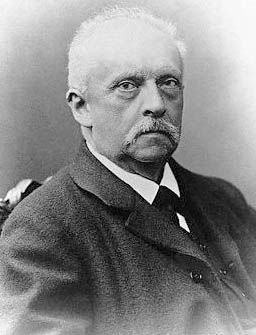Neuroscience
Who Was Psychology's First True Genius?
The real founder of psychology was not a psychologist.
Posted March 31, 2017
Here’s a one-item test: “Who founded the science of psychology?”
One possible answer would be “William James,” who wrote the first psychology textbook, Principles of Psychology, in 1890.
You would get a few more points for answering “Wilhelm Wundt.” Indeed, Wundt started the first formal laboratory in 1879, at the University of Leipzig, and William James was initially inspired to study psychology when he read one of Wundt’s papers in 1868, whilst visiting Germany.
But Wundt himself had started his career as a lab assistant to the man I would nominate as psychology’s first true genius: Hermann Helmholtz.
Helmholtz made at least two great contributions to modern psychology:
1. He was the first to measure the speed of a neural impulse. (In doing so, Helmholtz completely overturned the previous assumption that nervous signals were instantaneous, traveling at an infinite speed.)
2. He advanced the trichromatic theory of color vision, brilliantly inferring that there were three different types of color receptors in the eye, which responded specifically to blue, green, and red (an inference that was proven true a century later). This theory ran contrary to the view, popular only a few years before his time, that any kind of nerve cell could transmit any kind of information. It suggested not only that different kinds of neurons transmitted different kinds of information, but that even within the visual sense, there were different kinds of information being sent along different neurons in the eye.

There is one problem with identifying Helmholtz as psychology’s first genius: Helmholtz would not have defined himself as a psychologist. This is partly because there was no such field as psychology back in the early 1800s. Wilhelm Wundt was trained as a biologist, and William James as a philosopher. But both Wundt and James ended up defining themselves as psychologists. Helmholtz, on the other hand, started his career as a professor of physiology, and after dabbling in psychophysics for a while, switched his professional identity to become a professor of physics. His last years were devoted not to the scientific study of the mind, but to thermodynamics, meterology, and electromagnetism. Indeed, Helmholtz’s contributions to physics won him his widest acclaim. Those contributions led the emperor to promote him to the nobility (hence his name became Hermann von Helmholtz). (Helmholtz’s life was not exactly a rags to riches story, but it was certainly a noteworthy case of upward mobility. His father was a schoolteacher, and did not have the means to send his brilliant son to university to study physics. Instead, Helmholtz took advantage of a deal offered by the Prussian army – they would pay for his training in medicine, if he would agree to serve 8 years as an army surgeon after graduation). Along the way to becoming a member of the aristocracy for his acclaimed accomplishments in physics, and inspiring budding psychologists like Wundt and James, Helmholtz also invented the opthalmoscope, and wrote a textbook on optics that was widely used for half a century. While he was supposed to be studying Latin in high school, he was instead making optical diagrams under his desk. While he was in medical school, he found time to play the piano, read Goethe and Byron, and study integral calculus (Fancher & Rutherford, 2015).
Let’s look specifically at what was so ingenious about this young polymath’s studies of neural impulses and his theory of color vision, though.
Clocking the speed of a neural impulse.
What’s the big deal about measuring the speed of a neural impulse? Well, before Helmholtz’s time, the experts believed that a neural impulse was instantaneous, traveling at infinite or near infinite speed. When a pin pricks your finger, on that view, your brain is immediately aware of it. Helmholtz’s own advisor, the brilliant physiologist Johannes Müller, explained this presumed immediate transmission as outside the realm of scientific study, an example of the operation of the mysterious “life force” that underpinned the activities of all living organisms.
But Helmholtz and some of Müller’s other students believed there was no such mysterious force. Instead, they guessed that if you could shine a light on any process happening inside a living organism, you would discover merely the operation of basic chemical and physical events. As a young professor at the University of Konigsberg, Helmholtz devised an apparatus that hooked a frog’s foot to a galvanometer, in such a way that a current passed through the frog’s thigh muscle would trigger a kick that would turn off the electrical current. What he discovered was that when he zapped the frog’s leg closer to the foot, the twitch happened measurably faster than when he zapped further up the leg. This device led him to estimate an exact speed – the signal seemed to be traveling along frog’s leg’s neurons at 57 mph.
Then he repeated the study with living human beings. He taught his subjects to press a button as soon as they felt a poke to their legs. When he zapped the toe, it took longer for the subject to register it than when he zapped the thigh. Obviously, the toe is further from the brain, so this indicated that the neural impulse took measurably longer to register when it had to travel farther. This was amazing because people usually experience mental processes as happening instantaneously. And at the time, physiologists had been assuming that the underlying processes must also be instantaneous. If we were whales incidentally, it would take almost a full second for our brain to know that a fish had taken a bite out of our tail, and another full second to send a message back to tail muscle to swat the fish away.
During the next century, psychologists made great use of this “reaction time” method, using it to estimate how much neural processing is involved in different tasks (doing long division or translating a sentence in our second language versus adding two numbers or reading the same sentence in our native tongue, for example).
The three kinds of color-detecting receptors in the eye
Johannes Müller, who was Helmholtz’s advisor, may have clung to an archaic belief in an instantaneously-acting life force, but he also championed some revolutionary new ideas, including the “law of specific nerve energies” – which was the idea that every sensory nerve conducts only one kind of information. Psychology historian Raymond Fancher points out that one traditional view before then was that neurons were hollow tubes capable of transmitting any kind of energy – color, brightness, volume, tone, even scent or taste or skin pressure. But the new view was that each sense had its own separate neurons.
The trichromatic theory suggested that it was more specific than that – the eye might contain three different kinds of receptors, each one transmitting information about a particular section of the spectrum. Helmholtz noted that all the different colors of the spectrum could be reconstructed by combining lights of three primary colors – blue, green, and red. If you shine a green light and a red light at the same spot, you will see yellow. If you shine a blue light and a red light at the same spot you will see purple, and if you shine all three colors, you will see white. Helmholtz inferred from this that perhaps the brain could determine which color you were looking at if it integrated information from three types of retinal receptors. If the red receptors are firing away, but the blues are silent, you are seeing bright red, if the blue and red are both firing at a moderate pace, you are seeing a dull purple, etc. The idea had also been suggested earlier by the British physician Thomas Young, but Helmholtz developed it more fully. Today, the theory is called the Young-Helmholtz trichromatic theory.

A century later, in 1956, a physiologist at the University of Helsinki named Gunnar Svaetichin found direct support for the trichromatic theory by using microelectrodes to record the signals sent by different cells in fish retinas. Sure enough, some were maximally sensitive to blue, some to green, and some to red.
Even before this theory was directly supported, it had very important practical implications – television screens trick the eye into seeing colors not by reproducing all the colors of the rainbow, but by using only three kinds of pixels – red, green, and blue, and tweaking the brightness on each of those three channels produces images that our brain perceives as bright orange, dull tan, sparkling turquoise, and lustrous lavender.
Psychophysics and the discovery of human nature
Thinking about Helmholtz, and his fellow “psychophysicists,” can make us aware of just how much we have learned about human nature in the last two centuries. Philosophers had debated a number of questions about how the mind maps the physical universe, but the psychophysicists were able to use new and rigorous scientific methods to actually answer some of these basic questions. Physicists developed the methods to precisely measure the changes in physical energy in sound waves and light waves, and then the psychophysicists developed methods to record how people’s experiences changed, or did not change, along with those physical changes. What they discovered was that what the human brain experiences is not everything that is happening in the world. Some forms of physical energy, like infrared light or ultra-high pitched sound waves, are invisible to us, but obvious to other animals (like bees and bats). Other forms of energy are highly salient to us, but not to our pet cats and dogs (who lack different kinds of color receptors, and see the world in black and white, except with really loud smells).
Douglas T. Kenrick is author of:
- The Rational Animal: How evolution made us smarter than we think, and of:
- Sex, Murder, and the Meaning of Life: A psychologist investigates how evolution, cognition, and complexity are revolutionizing our view of human nature.
Related blogs
- Are there any geniuses in the field of psychology? Can psychology hold a candle to computer science?
- Who are psychology's geniuses (part II). Some brilliant psychologists I have known.
- What is psychology's single most brilliant discovery?
References
- Jameson, D., & Hurvich L.M. (1982). Gunnar Svaetichin: man of vision. Progress in Clinical and Biological Research, 13, 307-10.
- Fancher, R. E., & Rutherford, A. (2016). Pioneers of psychology (5th edition). New York: W.W. Norton & Co.




